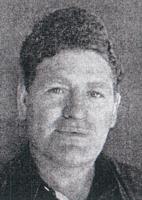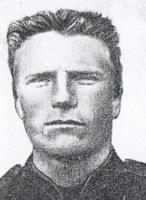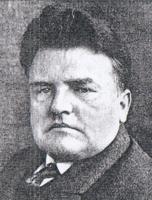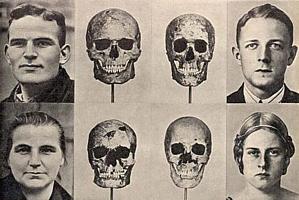





There are some important comments on the "Fälish" issue that I would like to make, and which, I believe, may clear-up a few points. Whilst reviewing the SNPA website, and the works of Hans F. K. Günther, I discovered a series of errors surrounding the concept of exactly what constitutes "Fälish". Firstly, the meaning of the term:
Etymology: The name Fälish, coined by Günther, derives from "Fälen", German for "plain".
This statement is incorrect. Whilst the meaning of the word is correctly given, its derivation is not. Günther (1930; 1933) stated quite specifically that the term "Fälish" (fälische Rasse), derived from Westfalen (Westphalia). Günther believed that this particular type was rather common in the German province of Westphalia, hence the name. Incidentally, the correct English name for this type would be "Phalian". Günther's term derives from Westfalen (Westphalia), a person who comes from that part of Germany is called Westphalian (Westfälische), in English. Therefore, fälisch once translated, is Phalian. The next error is this statement:
Other names: Dalo-Nordic (Paudler; from Dalarne)
Paudler (1924) did indeed employ the term "Dalic" (dalischen Typus), but the name "Dalo-Nordic" (dalo-nordische Unterrasse), was used by Eickstedt (1934).
Description: The pigmentation of the Fälish group is as light as that of any Nordic population. The hair is typically golden blond, the eyes blue.
Günther (1930) thought that reddish-blond hair and grey eyes were more common amongst people belonging to the Phalian type.
Origin: Iron Age Hallstatt Nordic altered by mixture with Upper Palaeolithic Borreby elements (or vice versa); a stabilized intermediate.
Whilst it is clear that such hybrid types do indeed exist, a name other than "Fälish" should be found for them. According to Paudler (1924), Kern (1927), Günther (1930; 1933) and Eickstedt (1934), the Fälisch/Dalisch type was a relatively unaltered Crô-Magnon descendant. In taxonomy, priority is considered a matter of prime importance: he who first names, defines. Therefore, Günther's definition of precisely what constitutes fälisch must be given primacy over other classifications that may be proferred. Granting the nomenclature of "Fälish" to this hybrid group, is therefore highly misleading. Now here, we arrive at the chief element of confusion:
Description: The short-headedness of the Borreby type carries over in some degree to the Fälish, which is typically sub-brachycephalic and not seldom brachycephalic.
According to all of the authorities previously cited, the Phalian type is long-headed. Günther (1930) states that the Phalian type is akin to Crô-Magnon man, and is distinguished by the following features: very tall stature; broad and powerfully-built body (in contrast with the slender and more delicately-built Nordic); dolichocephalic or mesocephalic head; low, broad face; steep, broad forehead, with heavy brow-ridges; low orbits; moderately broad nose; broad mouth with thin lips; broad and massive lower jaw with prominent chin; coarse, ruddy-fair skin; light, often reddish-blond, wavy or curly hair; deep-set blue or grey eyes. Günther's fälische Rasse is thus roughly equivalent to the Brünn type of Coon (1939).
A certain element of confusion appears to derive from the fact that Coon (1939) observed a high average cephalic index in northern Germany. This brachycephaly in a specific location, was then erroneously extended to a specific phenotype within that same area. Average cephalic indices do not, of course, indicate the figures for individuals.
Confusion also seems to have arisen from the work of Paudler (1924), who stated that Crô-Magnon types could be found in abundance in the Swedish province of Dalarne. In fact, according to Günther (1930), the people of that area are not particularly broad-faced. Only 4% of males from Dalarne combine broad faces with long heads. Equally, they are not especially tall in stature. Thus, they are not truly Phalian. Instead, Günther declares that they are largely Nordic and East Baltic in type. Because Günther thought that Phalians were uncommon in Dalarne, but quite common in Westphalia, he named the type fälisch.
In any case, I hope that this has resolved the contradictions and errors that have surrounded the term "Fälish".

SOURCES
Coon, C. S. (1939) The Races of Europe (New York: Macmillan).
Eickstedt, E. von (1934) Rassenkunde und Rassengeschichte der Menschheit (Stuttgart: Ferdinand Enke).
Günther, H. F. K. (1930) Rassenkunde des deutschen Volkes (Munich: J. F. Lehmann).
Günther, H. F. K. (1933) Kleine Rassenkunde des deutschen Volkes (Munich: J. F. Lehmann).
Kern, F. (1927) Stammbaum und Artbild der Deutschen und ihrer Verwandten (Munich: J. F. Lehmann).
Paudler, F. (1924) Die hellfarbigen Rassen und ihre Sprachstämme, Kulturen und Urheimaten (Heidelberg: Carl Winter).
LINKS
Hans F. K. Günther: Die fälische Rasse
SNPA Race Gallery: Fälish
SNPA Race Gallery: Brünn
Richard McCulloch: The Nordish Race